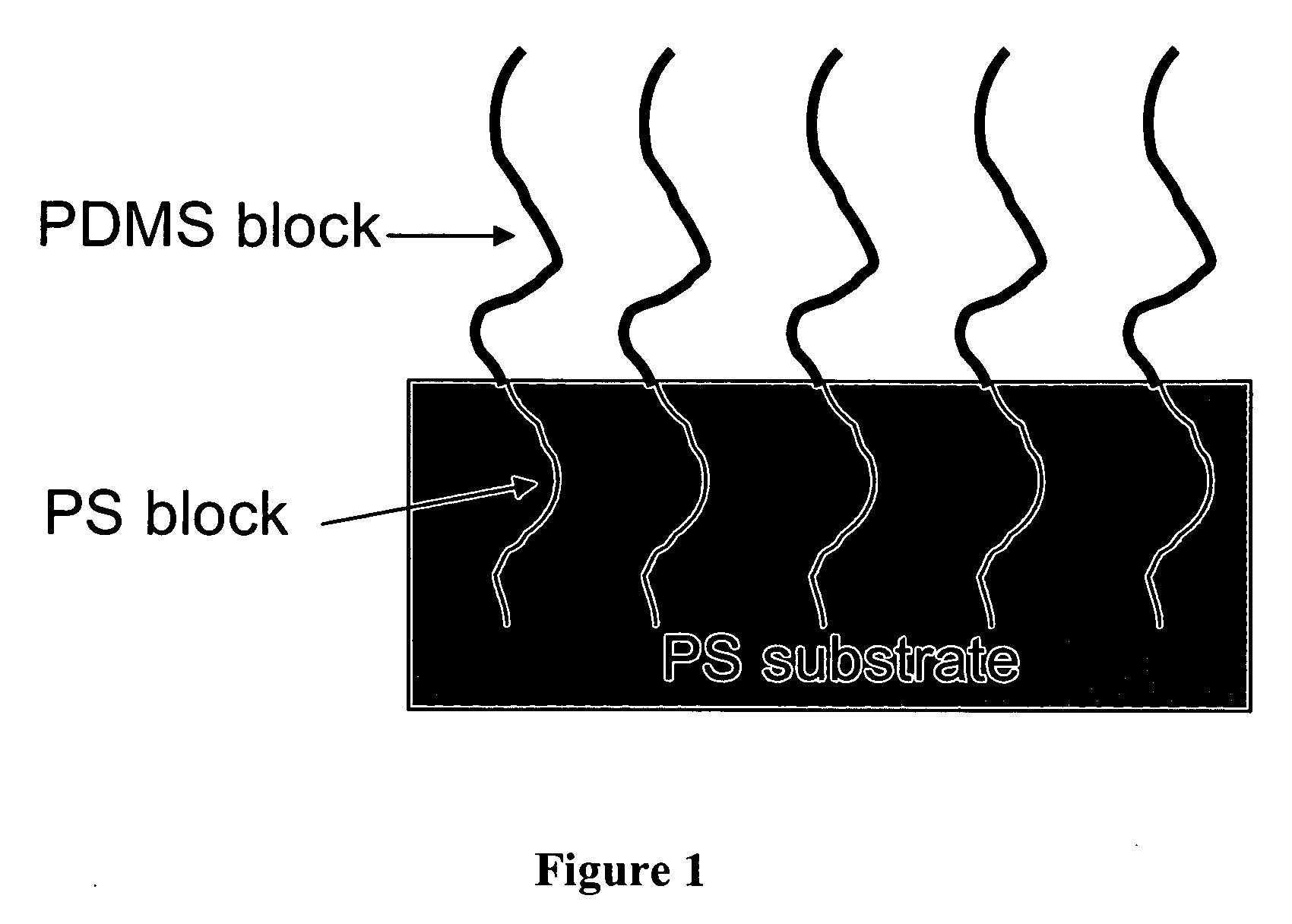Methods for modifying surfaces
a surface modification and surface technology, applied in the field of surface modification methods, can solve the problems of difficult control of surface chemistry modification depth, many surface modification methods under development are not readily suited to industrial applications and scale up, and the current surface modification strategy does not meet these conditions
- Summary
- Abstract
- Description
- Claims
- Application Information
AI Technical Summary
Problems solved by technology
Method used
Image
Examples
example 1
[0179] 4 mg of polystyrene-b-poly(t-butyl acrylate) (6.4K-7K, Polymer Source) was inserted into a high-pressure cell in every experiment regardless of carbon dioxide pressure. The corresponding concentration was 0.1 mg / cm3. PS fibers were placed inside a microcentrifuge tube located inside the high-pressure cell. The cell was charged with CO2 to desired pressure using an ISCO pump (260D). The temperature of the cell was controlled at 40° C. PS fibers were characterized with XPS and SEM.
[0180] The block copolymer, PS-b-PtBA, starts to adsorb onto PS fibers when the pressure of CO2 is above 25 MPa. FIG. 5 shows that the surface coverage of PS-b-PtBA increases with the pressure of CO2. At 46 MPa, PS-b-PtBA totally covers the surface. FIG. 6 gives the SEM images of PS fibers before and after covering with block copolymer. The original PS fibers have small pores at the surface. After coating, the pores disappeared and very smooth surfaces were obtained.
[0181] The adsorption kinetics of...
example 2
[0182] 1 mg of polystyrene-b-poly(t-butyl acrylate) (6.4K-7K, Polymer Source) was inserted into a high-pressure cell in every experiment regardless of carbon dioxide pressure. The corresponding concentration was 1.32 mg / cm3. A piece of silicon wafer was first spin coated with a layer of PS (152K, Pressure Chemical) with a thickness of about 50 nm, then placed inside a high-pressure cell. The cell was charged with CO2 to desired pressure using an ISCO pump (260D). The temperature of the cell was controlled at 46° C. The cell was maintained at the pressure for half an hour before releasing CO2. The modified samples were characterized with the contact angle measurement and XPS.
[0183] Contact angles of water on PS and PtBA films were measured and compared with those on the modified PS films (FIG. 8). The ratio of carbonyl carbon to total carbon can be obtained from XPS, because PtBA is the only source of carbonyl carbon. The XPS results are shown in FIG. 9. When CO2 pressure is below 8...
example 3
Self-Assembled Monolayers
Synthesis of 4-[4-(6-Mercapto-hexyloxy)-phenylazo]-benzoic acid t-butyl ester (Compound 1)
[0185] 4-[4-(6-Bromo-hexyloxy)-phenylazo]-benzoic acid t-butyl ester was synthesized following a reported procedure [Macromolecule, 1993, 26, 7103-05; J. Fluorine Chem., 1995, 74]. 4-Amino-benzoic acid t-butyl ester (Fluka, 4.81 g, 25 mmol) was dissolved in 55 mL of dilute hydrochloric acid aqueous solution. After cooling in an ice bath, the acid mixture was diazotized by adding drop-wise a solution of 1.73 g of NaNO2 in 5 mL of water at 0° C. to the acid mixture. The solution mixture turned a strong yellow. The solution was diluted with 100 mL of chilled methanol and coupling was carried out by slowly adding the diazotized solution to a chilled solution of phenol (2.34 g, 24 mmol), KOH (2.69 g, 48 mmol), and 25 mL of MeOH at 0° C. to form an orange-yellow precipitate. The solution was stirred for 2 hours in an ice water bath. The precipitate was filtered off, dried a...
PUM
| Property | Measurement | Unit |
|---|---|---|
| pressure | aaaaa | aaaaa |
| pressure | aaaaa | aaaaa |
| pressure | aaaaa | aaaaa |
Abstract
Description
Claims
Application Information
 Login to View More
Login to View More - R&D
- Intellectual Property
- Life Sciences
- Materials
- Tech Scout
- Unparalleled Data Quality
- Higher Quality Content
- 60% Fewer Hallucinations
Browse by: Latest US Patents, China's latest patents, Technical Efficacy Thesaurus, Application Domain, Technology Topic, Popular Technical Reports.
© 2025 PatSnap. All rights reserved.Legal|Privacy policy|Modern Slavery Act Transparency Statement|Sitemap|About US| Contact US: help@patsnap.com



